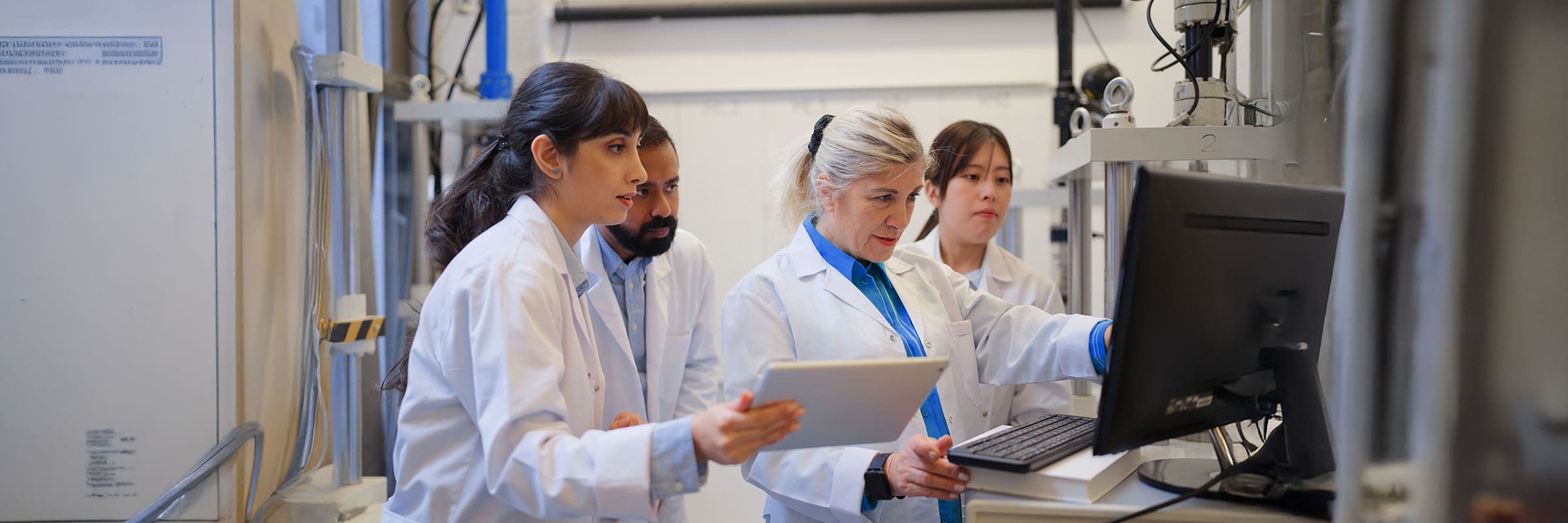How Canadian AI research is laying the foundations for tomorrow’s breakthroughs

“The work we’re doing now is undoubtedly creating the foundations for applications we can’t even dream of yet.”
Dugan O’Neil, Vice-President, Research and Innovation
Simon Fraser University
 High-performance computing – clusters of powerful processors that work in parallel to tackle massive, multidimensional data sets – enables researchers to solve complex problems quickly. Adding artificial intelligence (AI) into the mix opens up even more possibilities for advanced research. That level of processing power used to be needed in only a few academic disciplines, like physics and chemistry. But that’s changing.
High-performance computing – clusters of powerful processors that work in parallel to tackle massive, multidimensional data sets – enables researchers to solve complex problems quickly. Adding artificial intelligence (AI) into the mix opens up even more possibilities for advanced research. That level of processing power used to be needed in only a few academic disciplines, like physics and chemistry. But that’s changing.
Today, nearly every field of research, from drug development to crop protection, considers this kind of advanced computing capability as indispensable as electricity. As companies see opportunities to use AI in new ways, demand is going to grow beyond traditional research organizations.
Dugan O’Neil has witnessed this shift firsthand. He has played a leadership role in building Canada’s digital research infrastructure, including three years as Chief Science Officer at Compute Canada. Today, as Vice-President of Research and Innovation at Simon Fraser University, he oversees the Cedar Supercomputing Centre, one of Canada’s most powerful and energy-efficient data centres dedicated to academic research.1 Through Cedar, researchers across the country can take advantage of AI and high-performance computing resources, enabling them to do the cutting-edge research that helps keep Canada at the forefront of innovation.
“Canada has been one of the best places for AI research since at least the 1980s. This kind of infrastructure is vital to continuing that leadership and building a society that can compete on the international stage.”
The power to support innovation
Able to run petaflops (millions of billions) of operations per second, supercomputers have been supporting certain kinds of research for decades. One of their most common functions has been to enable simulations that dramatically reduce the time needed to design, build and test new technology.
For example, from the earliest days of supercomputing researchers have been doing computational fluid dynamics calculations to optimize the designs of aircraft wing. Instead of taking the time and resources to build a physical prototype for every model idea, and then testing each one in real wind tunnels, engineers can create and simulate tests for thousands of digital variations to isolate the handful of iterations worth testing in real-world conditions.
Expanding research possibilities
The advent of AI algorithms has supercharged these capabilities, expanding them into even more fields to solve even more complex problems, like protein structure. Having a better understanding of the right proteins can be the key to developing vaccines and even cures. But creating that protein structure presents substantial challenges.
“If you go into the laboratory and try and synthesize a cure, it’s going to take you a thousand years to test millions of possibilities,” says O’Neil. “Or you can use a supercomputer running a powerful AI algorithm to go through the same number of potential cures in minutes.”
In recent years, AI has enabled researchers to make tremendous headway in exactly these kinds of challenges. In 2025, for example, researchers at Simon Fraser University used AI to overcome a persistent challenge in protein research: while novel proteins could be invented in theory, they had until that point proven impossible to actually synthesize. Computing science professor Martin Ester’s work produced a system capable of assembling new molecules step-by-step, enabling researchers to see exactly how to build them.2
This work would not have been possible without access to the resources at the Cedar Supercomputing Centre.
“If you go into the laboratory and try and synthesize a cure, it’s going to take you a thousand years to test millions of possibilities. Or you can use a supercomputer running a powerful AI algorithm to go through the same number of potential cures in minutes.”
Getting AI into the hands of Canadian innovators
Thanks in part to federal support over the past several decades, Canada has been a leader in the development of these kinds of AI functions. That stability has helped turn the country into an AI research hub that has delivered multiple pioneering achievements and continues to attract high-calibre AI talent.
“The research strength in Canada is phenomenal,” says O’Neil. “Where we can improve is in AI adoption, capitalizing on all that expertise to create Canadian-born companies that are dominant players in the world of AI.”
While Canada’s researchers may lead in their fields, their discoveries are often commercialized by large companies from other countries that have the capacity to deliver on a much greater scale. For local companies to compete, there needs to be a path for smaller innovators to grow into large, commercial-scale enterprises.
Supporting Canadian AI leadership
The Cedar Supercomputing Centre is part of that path, providing computing power and expertise to support 17,000 researchers across the country, free of charge. These resources are currently only available for academic research, though industry and private enterprises are able to access them if it is part of an academic research project.
“So you might have a drone company interested in using AI to better detect disease in crops like blueberries,” explains O’Neil. “They might partner with a research group studying computer vision and image-recognition technologies so they can develop drones that can quickly identify infected plants from the air.”
Right now, Cedar is at full capacity, but Simon Fraser University is working with partners like Bell to scale up operations and create a parallel system available to private enterprises. Instead of being the commercial player in a research project, companies of all sizes will be able to initiate work with the experts at SFU and Cedar in order to develop solutions to their own challenges.
“We want to be able to offer them the same system, the same software setups and the same environment the academics are using, as well as the expertise that smaller companies probably don’t have on staff, like chemists, engineers and computer scientists,” says O’Neil.
“The research strength in Canada is phenomenal. Where we can improve is in AI adoption, capitalizing on all that expertise to create Canadian-born companies that are dominant players in the world of AI.”
Keeping Canadian innovations Canadian
Building the infrastructure needed to support Canadian research and keeping it in Canada is hugely valuable. Not only does that protect our data, but it reduces reliance on providers who may be subject to political or market pressures from outside the country. For this reason, O’Neil advocates for keeping as much of the entire supply chain in Canada as is reasonably possible, including network, software, GPUs, switches, power supplies and other infrastructure components.
From a business perspective, using a known product from an established foreign firm can seem like the easiest or most expedient option, but that can present its own risks. Sourcing from outside Canada can leave a supply chain vulnerable to disruption from conflicts, political/economic pressures and other events beyond a company’s control.
Non-Canadian suppliers may also be unable to guarantee valuable information (like health data or intellectual property) remains within Canada and could therefore be subject to another country’s laws. When a supply chain is international, the risk of delays due to geopolitical factors increases with every border crossing. Canadian components (particularly if they are newer to the market) may present their own initial risks, but this choice mitigates sovereignty risks, while also helping Canadian suppliers thrive and become more established – a true win-win.
Laying the foundations for the solutions of tomorrow
AI research is vital both for the questions we know it can solve and for the questions we haven’t even considered.
“Look at a company like Uber,” says O’Neil. “Their service depends on GPS, which depends on satellites, which depend in turn on rockets to launch them into space. And GPS would not work without precise corrections to the satellite clocks – corrections that come from Einstein’s theory of general relativity. Of course, Einstein wasn’t thinking about satellites, GPS or ridesharing. The scientific process is not linear. So the work we’re doing now is undoubtedly creating the foundations for applications we can’t even dream of yet.”
The key to making those applications possible is partnerships like the one between Simon Fraser University and Bell, which will help expand Cedar and the research opportunities it can enable, in particular by connecting it to the future Bell AI Fabric site at Thompson Rivers University. This site will be part of a national network of sovereign supercomputing facilities that will foster a vibrant and competitive innovation ecosystem to grow and retain talent while attracting AI investment to Canada.
Sources:
1. Bell, Advancing Canada’s AI and supercomputing ecosystem with Simon Fraser University.
2. Simon Fraser University, https://www.sfu.ca/sfunews/media/media-releases/2025/08/new-sfu-study-unveils-ai-that-designs-medical-drugs---and-tells-.html